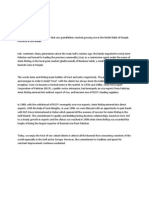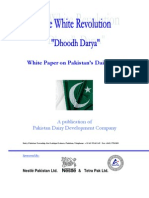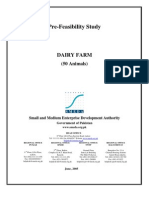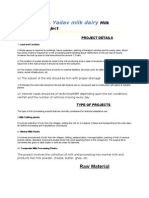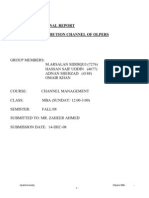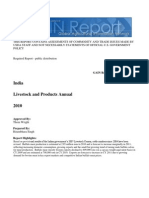Export of Live Animals From Pakistan
Export of Live Animals From Pakistan
Uploaded by
Řabbîâ KhanCopyright:
Available Formats
Export of Live Animals From Pakistan
Export of Live Animals From Pakistan
Uploaded by
Řabbîâ KhanOriginal Description:
Copyright
Available Formats
Share this document
Did you find this document useful?
Is this content inappropriate?
Copyright:
Available Formats
Export of Live Animals From Pakistan
Export of Live Animals From Pakistan
Uploaded by
Řabbîâ KhanCopyright:
Available Formats
Export of Live Animals From Pakistan
The strategic location of the country and potential of livestock sector creates a good export
avenue for our livestock. As far as export of live animals is concerned all the animals are kept under
quarantine for the required period and after necessary vaccination and tests are allowed for export.
There is a great demand for the export of live animals from Pakistan to Middle East countries and
Afghanistan also but it is subjected to Government policy for export of live animals which off and on
banned by the government. The export of animal casings is allowed only from the registered and
approved processing units. Similarly, there are registered bone-crushing factories in country that are
only allowed for export. The factories are up-grading their facilities to fulfill the more international
trade requirements. However, all these factories are fulfilling the international hygienic requirements
and W.T.O. standards. Measures have also been taken to meet Sanitary and Phytosanitary (SPS)
requirements under WTO for quality assurance and to improve exports of livestock and animal
products.
This increased consumption has created an incentive for the poor farmers to increase livestock
production thus creating an additional source of income. Moreover, livestock products also plays
very important role in covering the dietary protein deficiency for the farmers and human population.
It is assumed that the demand for food from animal origin will continue to rise, so there is a need on
the part of the government & representative trade bodies to assist, facilitate and guide the potential
exporters of live stock to earn for our beloved country. These measures would include amendments
in the regulations to over come some of the drawbacks which have resulted from increased
population and consumption of livestock. Thus reserving most of our lives stock/meat to be exported.
Primary focus should be on improvement of livestock production on sustainable basis which depends
upon the general animal health and better control of livestock diseases. Moreover improvement is
required in livestock marketing and trading system. In addition the institutions and human recourse
capacities also have to be strengthened.
Following are the major Opportunities and threats related to livestock sector.
Opportunities
1. Swift increase in consumption/demand of live stock products; in land and abroad.
2. Increasing demand of by-products, blood, skin, etc.; abroad.
3. Technological improvement in live stock production and processing in developed
countries which can be replicated in the developing countries.
Threats
1. Rise in the use of cereal based feeds for livestock hence increasing the cost of cereals
for human consumption
2. The continuous drought in the past decade and increasing demand of livestock has put
greater stress on grazing resources
3. Environmental and human health related concerns of urban dairy farms and poultry
farms near Major cities.
2 - LIVESTOCK IN PAKISTAN
The livestock sector is a leading sub-sector of the agriculture sector in Pakistan. In 2005-06 it
contributed over 10.7 per cent to the GDP which is more than the aggregated contribution of
entire crop sector of the country1. About 30-35 million people of rural areas are engaged in
raising livestock while deriving 30-40 per cent of their incomes from this sector.
According to Livestock Census 2006, there were 29.56 Million heads of cattle, 27.33 million
buffaloes, 26.49 million sheep and 53.79 million goats in Pakistan. Nationwide the combined
population of large ruminants, i.e. cattle and buffalo, was 56.89 million while the population
of small ruminants, i.e. goats and sheep, was 80.27 million.
3 - LIVE STOCK IN BALOCHISTAN
Balochistan area wise is the largest province of Pakistan with a total land mass of 348,189 sq.
km. it has a variety of geographic features including mountains, deserts, rangelands, forests
and coastal line. Livestock plays an important role in the economy of Balochistan in terms of
income and employment. Live stock production is an important source of income for the rural
poor in the province. It enables poor and landless farmers to earn income using common
property rangelands owned by different tribes.
Livestock is often the largest non-land asset in rural household portfolios. In arid and
semiarid settings, livestock can offer the only viable household sustenance strategy. In such
contexts, household welfare depends on herd size and the environmental factors that might
affect it. The rapidly growing demand for livestock products reinforces the value of livestock
as part of household asset portfolios and its potential to reduce poverty.
Table No. 3 : Livestock Population in Balochistan (2006)
The Sheep production in the country, 48 % of which occurs in Balochistan, increased just by
12 % from 23 million in 1996 census to 26 Million in 2006 census, During the same period
the Cattle production increased by 44%, Buffalo production increased by 34 % and Goats
Production increased by 30 %.
Total Number of Cattle, Sheep and Goats in Pakistan and Share of Balochistan
Province in National Herd
Percentage distribution of Sheep, Goats, Poultry, Cattle and Buffaloes in Balochistan
Sheep
38%
Goats
36%
Po
4 - PRODUCTION
The production of live stock for the last few years is given by the following tables, though it
is in increasing trend but still it is inefficient both in quantity and quality scale.
18%
Buffaloes
1%
Cattle4.2 Live Stock By-Products.
Table No. 5 : Livestock Products Production
7%
5 - GOVERNMENT INITIATIVES
Government has provided following incentives to increase livestock and poultry production
in the country:
Regulatory measures include allowing import of high yielding animals, semen and
embryos for crossbreeding, expansion/improvement and modernization of
laboratory facilities to diagnose and treat livestock diseases; introduction of mobile
animal health service to provide diagnostic services at the door steps of farmers,
duty free import of veterinary dairy and livestock machinery/equipment, not
manufactured in the country.
Government has allowed import of Incubators, Brooders, Evaporation cooling
pads, cooling system, Grain storage silos for poultry, poultry equipments,
milk and meat processing machinery/equipment (not manufactured locally),
at zero percent custom duty. Private sector has imported milk and meat processing
machinery/equipment worth of Rs 285 million during July-March, 2007-08.
In order to reduce input costs in poultry production, poultry vaccines, feed
additives, coccidiostats, Growth promoters premixes, Vitamin premixes, Fish feed,
Zinc sulphate, Copper sulphate used in poultry feed has been zero-rated. Sales tax
exemption has been allowed to un-cooked poultry meat; processed milk, yogurt,
cheese flavored milk, and butter cream. In addition, poultry, vaccines, feed
additives and coccidiostats used in poultry feed manufacturing have been allowed
at zero percent custom duty.
Following new development projects have been launched in the country during 2005-06 to
2007-08.
Livestock Production and Development project is of five years duration (2005
2010) and has total allocation of Rs 1520 million. It is assisting in the
establishment of 2590 fattening farms (1040 beef and 1550 mutton), 08
Slaughterhouses and 20 butcheries in private sector.
6 - ANIMAL QUARANTINE DEPARTMENT
The Animal Quarantine Department is working under Ministry of Live Stock . The Animal
Quarantine Department was established in 1980 to implement the Pakistan Animal
Quarantine (Import and export of animals and animal products) Act, 1979 and the
Pakistan Animal Quarantine (Import and export of animals and animal products) Rules,
1980.
The statutory authority and related regulations governing the transportation of animals and
animal products for import and export and regulation designed to prevent the introduction
and dissemination of exotic diseases and issuance of health certificates are the
responsibilities of the federal government under the constitution.
The Animal Quarantine Department is the executive veterinary authority of the federal
government with primary responsibility to regulate the import, export and quarantine of
animals and animal products in order to prevent the introduction and spread of exotic
diseases. The Animal Quarantine Department is not only important to safeguard the domestic
livestock of Pakistan but also has a very important role from human health point of view,
since there are number of bacterial viral and parasitic diseases which are communicable from
animals and animal products to human being.
The Animal Quarantine Department has a country-wide network of its Office cum
Laboratories. The Head office is at Karachi and sub-offices at Lahore, Islamabad, Peshawar,
Quetta, Multan, Sialkot, Gawadar, Khokhrapar and Khunjrab. The details of health certificate
issued for animals and animals products exported and clearance of reported cases of animals
and animals products imported during the year 2006-07 are provided in the following tables
Issuance of Health Certificates for Animals and Animal Products
Exported During the Year 2006-2007
Table No. 7.
6.1 Procedure for Quarantine of animals to be exported.
The Quarantine department provides certification service to the importers and exporters of
animals and animal products of uniform standard through examination and tests to meet the
international trade requirements. The department is also responsible to prevent the
unauthorized import and export of animals and animal products. It provides round-the-clock
services to the importers, exporters and general public with regard to import and export of
animals and animal products. Every point of entry and point of exit has to be guarded to
prevent the introduction or spread of diseases. Therefore, the department has office-cummicrobiology
laboratories of international standards located at Karachi, Lahore, Peshawar,
Islamabad, Quetta, Multan and Sialkot as per Clause-J of Section-2 of Pakistan Animal
Quarantine (Import and Export of Animals and Animal Products) (Amendment) Act, 1985.
The department handles all kinds of Animal which includes birds, cold blooded creatures: by
means of which any diseases may be carried or transmitted: four footed beasts which are not
mammals; mammals except man and the Animal Products. It means anything originating or
made, whether in whole or in part from an animal or from a carcass and other substance of
animal origin as specified by the Federal Government by notification in the official Gazette.
Pakistan being the member of OIE (Office of International Des Epizootics) and WTO is
obliged to maintain quarantine services of high standards. To safeguards the livestock
industry of Pakistan and foreign countries and human health from communicable diseases.
The Animal Quarantine Department is in a position to fulfill the international quarantine
requirements. A Laboratory for Drug Residues Detection from Animal Products at Karachi is
established to meet international trade standards for residues limit in animal productsProcedure /
Requirement for Quarantine of animals which are to be exported, under the
Pakistan Animal Quarantine (import and Export of Animals and Animal Products) Rules,
1980 is as under :
Section 12. Regulation of export. Every export of animals or animal products shall, as far as
may be, be regulated in accordance with the rules, regulations and zoo-sanitary conditions of
the country where such animals and animal products are exported.
Section 13. Quarantine of animal before export. All animals shall, before their export, be
kept in quarantine for such period and manner as the Quarantine Officer may determine for
carrying out tests and examinations and providing rest to such animals before their
transportation for export;
Provided that the period of rest shall not be less than ten hours which shall include three
consecutive hours between sunrise and sunset;
Provided further that if during the rest period of an animal, any other animal is brought into
quarantine, then the rest period of first animal detained in quarantine shall commence from
the time of arrival of the last animal in quarantine.
Section 14. Health certificate of an animal and animal product. (1) Where after the
examination of an animal or animal product and expiry of the rest period, the Quarantine
Officer is satisfied that such animal and animal product are free from disease, he shall issue a
health certificate in Form VII, Form IX or in product are intended to be exported.
No animal or animal product shall be exported unless it is accompanied by a health
certificate referred to in sub-rule. (1).
Section 15. Disembarkation of certain animals. Where an animal is injured during
transportation for export or loading in a vessel, aircraft or vehicle , or is found unfit to travel
due to illness, or where ealving or lambing of the animal during transit is reasonably
probable, or where adverse weather conditions are likely to cause serious injury or suffering
to such animal, the Quarantine Officer may under notice to the exporter , require the master
of the vessel, pilot of the aircraft or the person incharge of the vehicle, as the case may be, to
unload the animal and remove it to quarantine for rest and treatment
Section 16. Disinfection of aircraft, vehicle, etc. Before transportation of an animal or
animal product, the Quarantine Officer shall cause the cleaning and disinfection of a vessel,
aircraft or vehicle to be used for transportation for such animal and animal product by an
approved disinfectant .
Section 17. Quarantine charges and fees etc. to be notified. The rate of quarantine charges,
costs of keeping animals and animal products in quarantine, including feeding charges, fees
for examination, tests and certificates shall be fixed by the Federal Government , from time to
time by notification in the official Gazette.
Section 18. Destruction and disposal of diseased animals etc. (1) Any diseased animal or
animal product ordered to be destroyed under clause (e) of section 6 of the Ordinance or
under these rules shall be destroyed in accordance with the directions of the Quarantine
Officer.
(2) The carcass and destroyed animal product shall be disposed of by burying,
burning, cremated or incinerated.
(3) No compensation of an animal or animal product ordered to be destroyed
shall be paid to the owner.
(4) The items of any clothing, fittings or harness which had been in contact
with a diseased animal or animal product and not taken back by the importer after
disinfection shall be sold through auction.
Section 19. Sale proceeds to be deposited in Government treasury. All sale proceeds
received under these rules by sale or auction shall be deposited in the Government treasury
under the head 1260 Receipt from Economic Services-1261-Animal Husbandry-Others.
Section 20. Application of rules to animals and animal products in transit. These rules
shall, mutatis mutandis, apply to all animals an animal Products in transit by a vessel, aircraft
or vehicle.
(2) Where the Quarantine Officer examines any animal or animal product
landed in Pakistan during transit to another country, he shall make a health repot in Form XI
6.2 Export Constrains:
The major potential exports include animal casings, bone and its products, animal wastes, live
animals, meat, dry milk, wool, hair, feeding stuff for animals and poultry.
The export of livestock and its products constrained because of the presence of contagious
diseases, and poor sanitary/hygiene conditions of our slaughterhouses and slaughtering
practices and processing units for value addition.
The major reasons for lack of export trade are:
Absence of Disease Free Zones
Lack of proper regulatory law / rules
Non-existence of modern abattoirs and value addition
Quarantine procedures requirement in the importing countries.
7 - EXPORT OF LIVE STOCK.
Export of live stock means to sell Live Stock in another country. This involves complex
procedures, including filing and exchange of documents, both in the country of Export (from
where live stock are to be shipped/dispatched) and in the country of Import (where these
live stock are to be discharged/delivered). The requirement of documentation arises due to
the fact that the live stock that are exported are to be sold to some one who is thousands of
miles away, speaking a different language, having different customs, preferences, currency
and import regulations. In order to facilitate trade with other countries, certain sets of
rules have been developed by the trading nations over the centuries, which are normally
followed in foreign trade today. The International Trade is governed by rules made by
the World Trade Organization (WTO).
Export of live animals is allowed but you have to obtain an NOC from Ministry of Live stock
Government of Pakistan. In first step all animals shall before be kept in quarantine for such
period & manners as the Quarantine Officer may determined for carrying out tests,
examination and providing rest to the animals before their transportation for export. All
animals and birds under quarantine are subjected to the quarantine fees. The fee for
Quarantine and issuance of health certificate is different for different species and animal
products that is published in official gazette. Normally the duration of quarantine period is
two weeks but may be extended in certain conditions.
7.1 Export markets
Pakistan is geographically located close to the Middle East and South-East Asia. Both of
these regions are deficient in livestock products and depend upon import from other
countries. The livestock industry in most of the developed world is highly subsidized. With
reduction of subsidies in the wake of WTO, the local livestock sector should have better
opportunities to compete.
Procedure for Live Stock/Meat Export
7.2 Regulatory Environment For The Export Of Live Stock
The rules and regulations covering different livestock activities are given below:-
The import and export of livestock and livestock products are regulated by Pakistan
Animal Quarantine (Import and Export of Animal and Animal Products) Act, 1979 and
Rules 1980.
Import of livestock is subject to satisfying animal health requirements of Quarantine
Departments of importing/exporting countries. In a routine practice exporting country
submit specimen health certificate to Ministry of Livestock for vetting prior to
commencing export.
16
Export of live animals requires NOC from M/O Livestock , however, the issuance of the
same is suspended since 12 April 2004.
Export of semen, hatching eggs, live poultry, dairy products etc from Pakistan is subject
to satisfying animal health requirements of importing / exporting countries.
Export of meat is allowed / authorized from slaughterhouses established in the private
sector duly registered with Animal Quarantine Department of Ministry of Livestock and
Competent departments of importing countries.
The slaughtering of animals is regulated by Animal Slaughter Control Act 1963 and
Rules 1965 Union Council (Slaughterhouse Rules, 1961, Bye-laws for Regulation of
Public Slaughterhouse, 1980).
Livestock conservation is regulated by conservation (restriction on slaughter) of useful
Animals Act, 1956 while livestock breeding is being regulated by livestock breeding
schemes, 1960. The livestock protection is regulated by prevention of cruelty to animal
rules, 1961 and Ordinance 1981. Livestock nutrition is being regulated by animal
compound feeding Act 1974.
Livestock health is regulated by Animal Contagious Diseases Act 1948. The livestock
product quality is being regulated by Pure Food Ordinance 1960, Rule, Rules 1965 and
Agricultural Produce (Grading and Marketing) Act 1972.
7.3 Signing Of A Contract
When prices are accepted to export / import live stock then a contract is signed with the firm
for supply of live stock which becomes binding on both the buyer & seller. Contract is a
document, which normally contains.
a. Name of exporter of live stock
b. Name of importer of live stock
c. Breed of live stock
d. Unit price
e. Total quantity
f. Terms of delivery (FOB, C&F, CIF etc.)* Incoterms (international
commercial terms )deal with the questions related to the delivery of the
products from the seller to the buyer. This includes the carriage of products,
export and import clearance responsibilities, who pays for what, and who has
risk for the condition of the products at different locations within the transport
process. Incoterms are always used with a geographical location and do not
deal with transfer of title.
When the exporter is making an offer, he quotes the price of his product. If the
offer is accepted then a contract is signed between the buyer & the seller. The
contract includes terms and conditions under which goods are delivered.
17
The buyer sitting in the overseas market is normally not interested to receive
charge of goods at one's factory site but he may be interested to get charge of
goods on FOB basis which means free on Board at airport or seaport. It means
that charges of the consignment are fully paid up to that point and the rest of
the freight is paid by the buyer. Terms of delivery are not only important for
quoting price but it also makes clear as to who is responsible for the goods if
anything goes wrong.
g. Terms of payment (There could be basically two arrangements for payment;
first being through direct funds transfer without involving any credit facility.
This funds transfer could be both before the shipment of goods or after the
shipment of goods generally referred as Cash Against Documents (CAD).
Second arrangement is through the Letter of Credit (LC). The customers
bank provides a letter of credit, which promises to pay the supplier as long as
the terms are met. There are two types of LC, LC at sight and LC Deferred
payment. The payment may be paid immediately at sight or at a later date).
h. Mode of shipment (Sea, Air, Road)
i. Currency in which transaction will be made.
j. Validity period of a contract & delivery period.
k. Shipping marks if any.
l. Arbitration clause.
7.4 Required Documents
The following documents are required while undertaking exports from Pakistan :
1. Invoice
2. Form V 19
3. Form V 18
4. E-form (To claim duty drawbacks etc)
5. Packing list ( in case of Live stock variety /breed of Live stock )
6. Verified Certificate of Origin
7. Health certificate of an animal and animal product, issued by the Quarantine
Officer, in Form VII/ Form IX, under the Pakistan Animal Quarantine (import and
Export of Animals and Animal Products) Rules, 1980.
18
7.5 Post Shipment Documents
BCA (Bank Credit Advice) to be received from commercial banks after foreign exchange is
received. The BCA is considered proof for the purpose of rebates, refinance scheme etc.
7.6 How To Claim Duty Drawbacks
Duty Drawback is the most commonly availed incentive by exporters. It is the amount
reimbursed by the government to exporters as compensation for Customs Duty collected at
the time of import. For the purpose, FBR sets aside a certain percentage of customs duty
collected on imported raw material for appreciating Live Stock production. The following
documents must be in order when Exporter, files the claim for export rebate and submits the
file to the customs rebate section
1. Bank Credit Advice ( B.C.A )
2. Bill of Lading (First Original).
3. Railway Receipt (Attested by the Railways).
4. Customs Signed Invoice with Two Photocopies.
5. Packing list ( in case of Live stock variety /breed of Live stock )
6. Exchange Rate Certificate
7. Copy of Shipping Bill.
8. Photo Copy of Form E.
9. Laboratory Test Report. (if required)
10. Photocopy of SRO. (relevant to exporters product)
11. Copy of Cross Border Certificate (In case of export through land route).
12.Sales Tax Returns.
EXPORT TO AFGHANISTAN.
The government of Pakistan is providing various incentives regarding exports to
Afghanistan.
In Pak Rupee, Export of all commodities produced or manufactured in Pakistan, excluding
those manufactured in manufacturing bonds, would be allowed via land route, against Pakrupee
on filing of regular shipping bills without Form E. Such exports shall not be entitled
to;
Zero rating of Sales Tax on Taxable goods
Rebate of central excise duty
Repayment of drawback of customs duty
In Convertible Currency, all items and commodities produced or manufactured in Pakistan
exported, via land route or by air against irrevocable letters of credit, or advance payment, in
convertible foreign currency, shall be allowed;
Zero-rating of sales tax on taxable goods
Rebate of central excise duty
Repayment for drawback of customs-duty
Exports shall be subject to the following conditions:
The Pakistan Embassy or consulate in Kabul, Kandhar and Jalalabad would verify the arrival
of export consignments from Pakistan. This condition of verification from Pakistan missions
would remain suspended until these Missions or Sub-Missions become fully functional
The Federal Board of Revenue would strictly monitor the exports to Afghanistan and in case
of any misuse of the facility the item involved would be taken out of the permissible list by
the Ministry of Commerce.
Packages or retail packing would be clearly marked with the expression For Export Only,
provided that:
Only duty drawback rates or rebates would be available
Export would be allowed only through authorised export routes i.e. Torkhum and
Chaman
Export of goods which are made by or on behalf of International Relief Organizations against
International Tenders as relief goods to Afghanistan would be allowed the facility of normal
duty drawback, subject to the following
conditions:
The Export proceeds are realized in foreign currency.
Each individual packing of consignment bears indelible and prominent marking For
Export Only supply for aid to Afghanistan (insignia of the organization) not for sale
in Pakistan.
28
10.1 Following is a stepwise guide for exporting Live stock to Afghanistan.
1. There is now a banking system in place in Afghanistan. Habib Bank Limited has
opened a branch in Kabul and the National Bank of Pakistan has opened two
branches one in Jalalabad and the other in Kabul. Fund transfer facilities are
available however LC facilities have not yet been started. The systems of Hundi
or Hawala are still being used alongside new commercial banking facilities.
2. All exports to Afghanistan are mostly undertaken against advance cash payment.
However, some buyers are also using Dubai banking channel for remitting
Foreign Currency as advance payments.
3. The importer contacts the local authorized dealer/bank of the exporter and deposits
advance money in the account of the exporter. He also fills out a form V 19
(Annex 1) which is an undertaking on part of the importer and exporter of the
transaction to be made.
4. The authorized dealer/bank, after verifying the documents pays the exporter in Pak
Rupees (against dollars as deposited by the importer).
5. The exporter fills out another form V 18 (Annex 2) which includes details of the
exporter, his contact address, goods to be exported etc. This form is reported
by Authorised Dealer (A.D) to The State Bank of Pakistan for Exchange Return
purposes.
6. A certificate of origin, verified from the relevant Chamber of Commerce and
Industry is required that ensures that the exporter is a listed exporter and can
undertake the transaction.
7. Once the payment has been received, in advance, the Form E (Annex 3) is certified
and endorsement of advance payment is made by the bank. The shipping documents
i.e commercial invoice of Live Stock is prepared by the exporter
8. After completion of documentary requirements, the Live Stock are loaded in trucks
and transported to the Pakistani border at Torkhum and Chaman. The Afghan
authorities usually do not allow any transport company to operate its trucks in
Afghanistan.
9. Once the goods reach the Pak border, the Shipping Bill/Bill of Exports/Pakistan Good
Declaration (PGD) of the consignment is submitted to the Deputy Superintendent
(DS) customs for clearing.
10. After clearance from DS customs, the consignment is marked to the Inspector
Customs who after examination gives his report on the shipping bill and marks the
case again to DS.
29
11. After approval from Deputy Superintendent (DS) custom the shipping bill is then
again forwarded to the relevant authority for further verification.
12. Once the Live Stock have been cleared by officials at the Pakistan border, they are
allowed to cross over into Afghanistan.
13. As the goods cross Pakistans border, all documents i.e Copy of Truck Receipt,
Shipping Bill, Commercial Invoice, Duplicate & Triplicate Form E are sent to the
authorized dealer/bank by the exporter within 21 days from the date of Form E
certification or 14 days from the date of shipment/dispatch of goods which ever is
earlier. The A.C is to verify that the export of goods has been made and the entire
export transaction is completed. Finally the A.C issues EPRC (Export Proceeds
Realization Certificate) to Exporter and also sends a copy of shipping documents to
the State Bank of Pakistan so that they can close their books of account and the entire
export process is documented there.
You might also like
- Feasibility by AGROTECH CholistanDocument75 pagesFeasibility by AGROTECH CholistanfcspvtltdNo ratings yet
- SB Feed MillsDocument8 pagesSB Feed Millsanum8991100% (1)
- Slaughtr Houses in PakistanDocument6 pagesSlaughtr Houses in PakistanNasar Ullah KhanNo ratings yet
- Case StudyDocument5 pagesCase StudyNaqash ArifNo ratings yet
- Current Scenario and Growth Prospects For Meat and Raising India's Share in Global MarketsDocument11 pagesCurrent Scenario and Growth Prospects For Meat and Raising India's Share in Global MarketsAmrit100% (1)
- Poultry Industry of PakistanDocument5 pagesPoultry Industry of Pakistanhamid_irfan_najmiNo ratings yet
- Imports and Exports of FoodsDocument24 pagesImports and Exports of FoodsAmit JainNo ratings yet
- Ai 410 e 00Document27 pagesAi 410 e 00Lukman PitonoNo ratings yet
- Amin Ittefaq Rice MillsDocument5 pagesAmin Ittefaq Rice MillsShams Ullah100% (1)
- 00 Pedoman Feedlot Baru 2017 PDFDocument89 pages00 Pedoman Feedlot Baru 2017 PDFNaufal Boutcyah SpemaNo ratings yet
- Pakistan Rice Export IndustryDocument30 pagesPakistan Rice Export Industrykindhearted19No ratings yet
- World Sheep Meat Market To 2025 PDFDocument48 pagesWorld Sheep Meat Market To 2025 PDFOghenevwede OtegheleNo ratings yet
- Pakistan Pharmaceutical IndustryDocument37 pagesPakistan Pharmaceutical IndustryTalha A SiddiquiNo ratings yet
- Fertilizer Directory OF PakistanDocument9 pagesFertilizer Directory OF Pakistankapil_rahtiNo ratings yet
- Top 50 Exporters of Pakistan in 2020Document9 pagesTop 50 Exporters of Pakistan in 2020Software EngineerNo ratings yet
- List of Poultry Feed Mills in PunjabDocument14 pagesList of Poultry Feed Mills in PunjabUmer Farooq100% (2)
- Cattle Breeds in Pakistan - 1st ClassDocument8 pagesCattle Breeds in Pakistan - 1st ClassKaleem Sandhu100% (1)
- Detailed Project Report Foxnut (Makhana) Processing Unit Under Pmfme SchemeDocument27 pagesDetailed Project Report Foxnut (Makhana) Processing Unit Under Pmfme SchemePratik KumarNo ratings yet
- Export Fruit N VegDocument10 pagesExport Fruit N VegMisbahMoidNo ratings yet
- Multan AssociateDocument51 pagesMultan AssociateTALHA MAFBIS100% (1)
- Pakistan Dairy IndustryDocument107 pagesPakistan Dairy Industrysuhaib.ammar94% (16)
- Market+Roadmap+ +ugandaDocument99 pagesMarket+Roadmap+ +ugandaMuse AFNo ratings yet
- BDSP-Updated ListDocument7 pagesBDSP-Updated ListPmLUniteDNo ratings yet
- Project Proposal Part-A Organization ProfileDocument11 pagesProject Proposal Part-A Organization ProfileManjunath GC100% (1)
- Dairy Farm (50 Animal)Document39 pagesDairy Farm (50 Animal)Blue MoonNo ratings yet
- List of Labels Woven in PakistanDocument31 pagesList of Labels Woven in PakistanSayed Aasim JawaidNo ratings yet
- Yadav Milk Dairy Milk Processing ProjectDocument5 pagesYadav Milk Dairy Milk Processing ProjectRajesh YadavNo ratings yet
- SMEDA Export To AfghanistanDocument18 pagesSMEDA Export To AfghanistanAbhas GargNo ratings yet
- Altech Prime GroupDocument30 pagesAltech Prime GroupIssa BilalNo ratings yet
- Poultry Feed Mills in PunjabDocument21 pagesPoultry Feed Mills in PunjabKazimNo ratings yet
- List of NGOs in PakistanDocument34 pagesList of NGOs in PakistanBanaras KhanNo ratings yet
- NZ Goat Industry Report To Federated Farmers 14 Mar 2017Document100 pagesNZ Goat Industry Report To Federated Farmers 14 Mar 2017MUHAMMAD ARIFNo ratings yet
- Fishing Industry of PakistanDocument17 pagesFishing Industry of PakistanRaza Hassan100% (2)
- Specifications of Feed Ingredients and Finished Feeds Bis Standard 160216162247 PDFDocument37 pagesSpecifications of Feed Ingredients and Finished Feeds Bis Standard 160216162247 PDFkotresha komaragoudraNo ratings yet
- Control ShedDocument39 pagesControl Shedshani2763% (8)
- Feed MillsDocument7 pagesFeed MillstahaNo ratings yet
- Poultry Feeds in PakistanDocument3 pagesPoultry Feeds in PakistanjamalNo ratings yet
- Production Parameters Problem SolvingDocument53 pagesProduction Parameters Problem SolvingMonaliz NagrampaNo ratings yet
- Fisheries 1 HDocument19 pagesFisheries 1 HShanzae KhalidNo ratings yet
- Final CDL Foods LimiteDocument50 pagesFinal CDL Foods LimiteluckylibraNo ratings yet
- Policy Brief - Central Asian Trade and AfghanistanDocument10 pagesPolicy Brief - Central Asian Trade and AfghanistanAPPROCenterNo ratings yet
- Vendor Registration Database April-2015 UpdatedDocument544 pagesVendor Registration Database April-2015 UpdatedFerzia Firdousi100% (1)
- SorbatoxbrochureDocument6 pagesSorbatoxbrochureVet.Hek. Süleyman ÜRKMEZ100% (1)
- Milk Production in Dry Zone - Sunil GamageDocument8 pagesMilk Production in Dry Zone - Sunil GamageSunil GamageNo ratings yet
- PDCM Report On VenkyDocument19 pagesPDCM Report On VenkymeghnakhandelwalNo ratings yet
- Sugar Industry of PakistanDocument30 pagesSugar Industry of Pakistanadnaneconomist100% (9)
- An Exploratory Study On Competitive Milk Brands With Reference To Pathanamthitta DistrictDocument78 pagesAn Exploratory Study On Competitive Milk Brands With Reference To Pathanamthitta DistrictShamilpsNo ratings yet
- Distribution Channel of OlpersDocument32 pagesDistribution Channel of OlpersWajahat MumraizNo ratings yet
- Final Mango Guidelines Eng VersionDocument64 pagesFinal Mango Guidelines Eng Versionសរ ឧត្តមNo ratings yet
- Milk Production Trends in BDDocument22 pagesMilk Production Trends in BDAyon KhanNo ratings yet
- 09 - Animal Care HandbookDocument32 pages09 - Animal Care HandbookMazhar HassnainNo ratings yet
- Poultry SectorDocument81 pagesPoultry Sectornoman2008100% (1)
- Pakistan's Halal Meat SectorDocument13 pagesPakistan's Halal Meat SectorErfan MirxaNo ratings yet
- Animal HusbandryDocument69 pagesAnimal HusbandryKabi RockNo ratings yet
- Strategy & Strategic PlanDocument45 pagesStrategy & Strategic PlanSatish Chandra TiyuNo ratings yet
- Livestock: Bangladesh Delta Plan 2100 Formulation ProjectDocument188 pagesLivestock: Bangladesh Delta Plan 2100 Formulation Projectrubel_nsuNo ratings yet
- Government Strategiesfor Livestock DevelopmentDocument5 pagesGovernment Strategiesfor Livestock DevelopmentNaeem AbbasNo ratings yet
- Anwar SBDocument19 pagesAnwar SBAdeel AshiqNo ratings yet
- India Livestock ReportDocument9 pagesIndia Livestock Reportgoyal.rohit8089No ratings yet
- Poultry ProductionDocument11 pagesPoultry ProductionnoblekuruNo ratings yet
- PIA Jan 2014 - Feb 2014 Comsats Fab 2016 - Jan 2017 IMIT-AIOU Islamabad Sep 2017 - Jan 2018Document1 pagePIA Jan 2014 - Feb 2014 Comsats Fab 2016 - Jan 2017 IMIT-AIOU Islamabad Sep 2017 - Jan 2018Řabbîâ KhanNo ratings yet
- Office of International Students Beijing Institute of TechnologyDocument34 pagesOffice of International Students Beijing Institute of TechnologyŘabbîâ KhanNo ratings yet
- Marketing Group Project 2019Document3 pagesMarketing Group Project 2019Řabbîâ KhanNo ratings yet
- Chapter 4 For Next WeekDocument28 pagesChapter 4 For Next WeekŘabbîâ KhanNo ratings yet
- History of Special Education in PakistanDocument7 pagesHistory of Special Education in PakistanŘabbîâ KhanNo ratings yet
- Marketing Decision MakingDocument18 pagesMarketing Decision MakingŘabbîâ KhanNo ratings yet
- Mutual FundsDocument30 pagesMutual FundsŘabbîâ KhanNo ratings yet
- Oil and Gas Development CompanyDocument6 pagesOil and Gas Development CompanyŘabbîâ KhanNo ratings yet
- Report of Coca ColaDocument40 pagesReport of Coca ColaŘabbîâ KhanNo ratings yet
- Trade Cycle: Through Graph and Figures We Can Show It How It Is in Recession and BoomDocument7 pagesTrade Cycle: Through Graph and Figures We Can Show It How It Is in Recession and BoomŘabbîâ KhanNo ratings yet
- Impact of Deceptive Advertisement On Consumer Buying BehaviorDocument8 pagesImpact of Deceptive Advertisement On Consumer Buying BehaviorŘabbîâ KhanNo ratings yet








